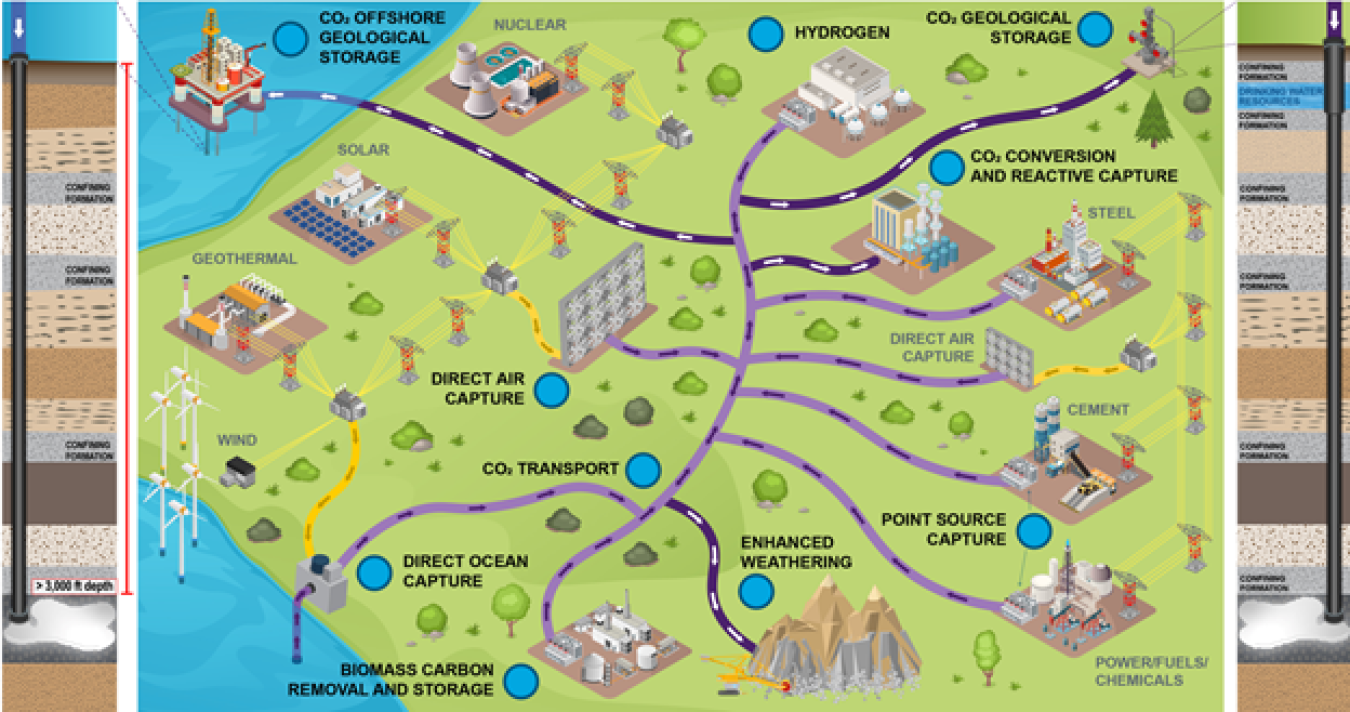Highlights
Carbon management is essential to limiting warming to a threshold of 1.5°C
What is carbon management?
Carbon management is a term used to describe a variety of technologies and practices that reduce carbon dioxide emissions, including:
- Carbon capture: capturing carbon dioxide from industrial facilities and power plants
- Carbon conversion: converting captured carbon emissions into useful products
- Carbon dioxide removal: removing carbon dioxide directly from the atmosphere and ocean
- Carbon transport: transporting carbon dioxide from where it is captured to where it can be geologically stored or put to beneficial use
- Carbon storage: storing carbon dioxide safely and permanently in geologic formations
- Hydrogen with carbon management: capturing carbon dioxide emissions generated from converting natural gas, biomass, and/or waste feedstock materials to hydrogen
Why do we need carbon management?
Carbon management is necessary to help reduce current carbon emissions to net-zero by midcentury and ultimately remove legacy carbon dioxide emissions already in the atmosphere. However, carbon management is a complement to, not a replacement of, the urgent need for expanded and parallel efforts to reduce emissions through aggressive deployment of energy efficiency, renewables, nuclear power, clean hydrogen, and other clean energy and industrial technologies and measures.
How is DOE advancing carbon management?
The United States will need to capture, transport, and permanently store hundreds of millions of tons of carbon dioxide each year in order to achieve a clean energy and industrial future by midcentury.
The work has already begun to meet this challenge. Over the past two decades, DOE has invested billions of dollars into more than a thousand carbon management projects across the country. These projects advance the research, development, demonstration, and commercial-scale deployment of carbon management technologies and infrastructure. Additionally, these efforts expand the United States’ carbon management capabilities to reduce harmful carbon pollution from industrial and power sectors and address climate change.
Where can I learn more about carbon management?
Work by the Intergovernmental Panel on Climate Change and broader scientific consensus is clear about the importance and necessity of carbon management for reaching climate goals.
However, DOE recognizes the need for accessible information grounded in science for the broader public, impacted stakeholders, and local communities to better understand carbon management technologies and represent themselves in project development conversations. DOE has created multiple resources in various formats to provide stakeholders with information to learn about the rapidly evolving field of carbon management. Check out some of these resources below.
Featured Report
Press Releases
-
- Carbon Management
January 16, 2025 -
- Carbon Capture
- Carbon Management
January 14, 2025 -
- Carbon Management
December 20, 2024 -
- Carbon Management
December 13, 2024 -
- Coal
- Carbon Capture & Sequestration
- Carbon Management
November 14, 2024 -
- Carbon Management
- Clean Energy
- Tribal Energy Access
- Inflation Reduction Act
- Bipartisan Infrastructure Law
November 1, 2024 -
- Carbon Management
- Environmental and Legacy Management
- Decarbonization
- Bipartisan Infrastructure Law
- Tribal Energy Access
October 21, 2024
From Our Blogs
-
- Carbon Capture
- Carbon Management
- Decarbonization
- Net Zero Economy
- Fossil
October 7, 2024 -
- Carbon Management
- Clean Energy
- Energy Workforce
- Next-Generation Energy Technologies
- Research, Technology, and Economic Security
September 16, 2024 -
- Industrial Decarbonization Technologies
- Carbon Capture
- Carbon Management
- Decarbonization
- Clean Energy
September 9, 2024 -
- Carbon Management
- Decarbonization
- Industrial Decarbonization Technologies
- Bipartisan Infrastructure Law
- Clean Energy
September 5, 2024
Upcoming Events
Supporting Offices
-
- Carbon Management
- Environmental and Legacy Management
- Decarbonization
- Bipartisan Infrastructure Law
- Tribal Energy Access
-
-


